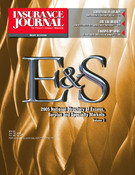Five large family passenger cars and three large luxury models have earned top ratings in frontal crash tests by the insurance industry.
The highest ratings in the tests went to 2005 family vehicles such as the Buick LaCrosse, Chrysler 300, Ford Five Hundred, Kia Amanti, Toyota Avalon and three luxury passenger cars–Acura RL, Cadillac STS and Lexus GS.
In the front crash test, vehicles strike a barrier on the driver side at 40 mph.
Adrian Lund, COO at the Insurance Institute for Highway Safety, said Chrysler had made strides in the frontal protection offered by the 300.
In 1999, two of the 300’s predecessors, the Chrysler LHS, and its corporate twin 300M, received the institute’s lowest rating for frontal crashes.
But in the recent tests, the 300’s front compartment maintained its shape, letting the air bag and seat belt protect the dummy. When the dummy moved forward into the air bag, it returned to the seat without its head striking any structure that could have caused injury.
Lund called the 300 a “good performer across the board in the frontal test. This is the kind of performance we like to see.”
Max Gates, a DaimlerChrysler AG spokesman, said the institute’s test was one of many that the automaker takes into account when it designs and engineers vehicles.
“While no single test can determine a vehicle’s overall safety performance, the Chrysler Group continues to pursue every opportunity to improve the crashworthiness of its vehicles,” Gates said.
The institute commended Ford Motor Co. for the steady performance of the Five Hundred, noting that previous Ford family sedans–the 1995, 1996 and 2000 models of the Taurus–received top ratings in frontal tests.
The 2005 Acura RL was also considered an improvement, with previous versions rated acceptable because the dummy’s head struck the pillar between the front and rear doors in testing.
The 2005 RL had an improved structure that reduced the likelihood of injuries in a similar crash, Lund said.
It also found improvement in Cadillac’s crashworthiness for the STS. The STS’s immediate predecessor, the 2000 Seville, earned a good rating in the frontal test, but the 1997 Seville was rated poor because its structure crumpled during the crash test and the instrument panel pushed back toward the driver.
General Motors Corporation spokesman Alan Adler said the 1997 Seville’s structure had few changes from the 1992 model and the improvements came as part of an evolution of the vehicle.
“These vehicles are all about continuing improvements and getting better from a structural standpoint,” Adler said.
Copyright 2005 Associated Press. All rights reserved. This material may not be published, broadcast, rewritten or redistributed.
Was this article valuable?
Here are more articles you may enjoy.


 SIAA Announces Strategic Partnership With Progressive
SIAA Announces Strategic Partnership With Progressive  Alliant Latest to Sue Howden US Over Alleged ‘Smash-and-Grab’ Poaching
Alliant Latest to Sue Howden US Over Alleged ‘Smash-and-Grab’ Poaching  Door of Swiss Bar Where 40 Died in Fire Was Locked, Says RTS
Door of Swiss Bar Where 40 Died in Fire Was Locked, Says RTS  Florida Lawmakers Ready for Another Shot at Litigation Funding Limits
Florida Lawmakers Ready for Another Shot at Litigation Funding Limits 


